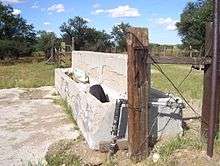Manger

A manger, or trough, is a structure used to hold food to feed animals. The word manger originally referred to a feed-trough, but it may also be used to refer to a water-trough when this is not being used possibly because it is similar to an abreuvoir. Mangers are generally found at stables and farmhouses. A manger is generally made of either stone or wood or metal. Mangers are mostly used in livestock raising.[1]
They are also used to feed wild animals, e.g., in nature reserves. The word comes from the French manger (meaning "to eat"), from Latin manducare (meaning "to chew").
A manger is also a Christian symbol, associated with nativity scenes where Mary and Joseph, forced by necessity to stay in a stable instead of an inn, used a manger as a makeshift crib for the Baby Jesus.[2] (Greek: φατνη phatnē; Luke 2:7).
Gallery

 Nativity at Night by Geertgen tot Sint Jans, c. 1490, after a composition by Hugo van der Goes of c. 1470. Sources of light are the infant Jesus, the shepherds' fire on the hill behind, and the angel who appears to them.
Nativity at Night by Geertgen tot Sint Jans, c. 1490, after a composition by Hugo van der Goes of c. 1470. Sources of light are the infant Jesus, the shepherds' fire on the hill behind, and the angel who appears to them.
See also
- Artesa, Spanish term for a trough also used in bread making
- Abreuvoir
- Away in a Manger, a Christmas carol
References
- ↑ Mahoney, Leonardo (1996). 5,000 years of Architecture in Malta. Malta: Valletta Publishing. Format. p. 123-124. ISBN 9990958157. ISBN 9789990958157.
- ↑ William, Francis Dawson (1902). Christmas: Its Origin and Associations. E. Stock. Retrieved 2014-12-25.